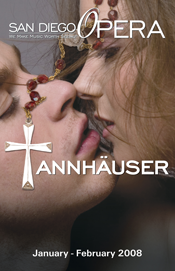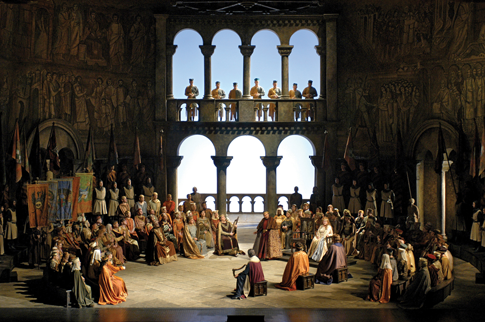
17 Feb 2008
Tannhäuser at San Diego Opera
To open its 2008 season, San Diego Opera restored the production of Richard Wagner's Tannhäuser that Günther Schneider-Siemsson created for the Metropolitan Opera three decades ago.
English Touring Opera are delighted to announce a season of lyric monodramas to tour nationally from October to December. The season features music for solo singer and piano by Argento, Britten, Tippett and Shostakovich with a bold and inventive approach to making opera during social distancing.
This tenth of ten Live from London concerts was in fact a recorded live performance from California. It was no less enjoyable for that, and it was also uplifting to learn that this wasn’t in fact the ‘last’ LfL event that we will be able to enjoy, courtesy of VOCES8 and their fellow vocal ensembles (more below …).
Ever since Wigmore Hall announced their superb series of autumn concerts, all streamed live and available free of charge, I’d been looking forward to this song recital by Ian Bostridge and Imogen Cooper.
Although Stile Antico’s programme article for their Live from London recital introduced their selection from the many treasures of the English Renaissance in the context of the theological debates and upheavals of the Tudor and Elizabethan years, their performance was more evocative of private chamber music than of public liturgy.
Evidently, face masks don’t stifle appreciative “Bravo!”s. And, reducing audience numbers doesn’t lower the volume of such acclamations. For, the audience at Wigmore Hall gave soprano Elizabeth Llewellyn and pianist Simon Lepper a greatly deserved warm reception and hearty response following this lunchtime recital of late-Romantic song.
For this week’s Live from London vocal recital we moved from the home of VOCES8, St Anne and St Agnes in the City of London, to Kings Place, where The Sixteen - who have been associate artists at the venue for some time - presented a programme of music and words bound together by the theme of ‘reflection’.
'Such is your divine Disposation that both you excellently understand, and royally entertaine the Exercise of Musicke.’
‘And there was war in heaven: Michael and his angels fought against the dragon; and the dragon fought and his angels, And prevailed not; neither was their place found any more in heaven … that old serpent … Satan, which deceiveth the whole world: he was cast out into the earth, and his angels were cast out with him.’
There was never any doubt that the fifth of the twelve Met Stars Live in Concert broadcasts was going to be a palpably intense and vivid event, as well as a musically stunning and theatrically enervating experience.
‘Love’ was the theme for this Live from London performance by Apollo5. Given the complexity and diversity of that human emotion, and Apollo5’s reputation for versatility and diverse repertoire, ranging from Renaissance choral music to jazz, from contemporary classical works to popular song, it was no surprise that their programme spanned 500 years and several musical styles.
The Academy of St Martin in the Fields have titled their autumn series of eight concerts - which are taking place at 5pm and 7.30pm on two Saturdays each month at their home venue in Trafalgar Square, and being filmed for streaming the following Thursday - ‘re:connect’.
The London Symphony Orchestra opened their Autumn 2020 season with a homage to Oliver Knussen, who died at the age of 66 in July 2018. The programme traced a national musical lineage through the twentieth century, from Britten to Knussen, on to Mark-Anthony Turnage, and entwining the LSO and Rattle too.
With the Live from London digital vocal festival entering the second half of the series, the festival’s host, VOCES8, returned to their home at St Annes and St Agnes in the City of London to present a sequence of ‘Choral Dances’ - vocal music inspired by dance, embracing diverse genres from the Renaissance madrigal to swing jazz.
Just a few unison string wriggles from the opening of Mozart’s overture to Le nozze di Figaro are enough to make any opera-lover perch on the edge of their seat, in excited anticipation of the drama in music to come, so there could be no other curtain-raiser for this Gala Concert at the Royal Opera House, the latest instalment from ‘their House’ to ‘our houses’.
"Before the ending of the day, creator of all things, we pray that, with your accustomed mercy, you may watch over us."
The doors at The Metropolitan Opera will not open to live audiences until 2021 at the earliest, and the likelihood of normal operatic life resuming in cities around the world looks but a distant dream at present. But, while we may not be invited from our homes into the opera house for some time yet, with its free daily screenings of past productions and its pay-per-view Met Stars Live in Concert series, the Met continues to bring opera into our homes.
Music-making at this year’s Grange Festival Opera may have fallen silent in June and July, but the country house and extensive grounds of The Grange provided an ideal setting for a weekend of twelve specially conceived ‘promenade’ performances encompassing music and dance.
There’s a “slide of harmony” and “all the bones leave your body at that moment and you collapse to the floor, it’s so extraordinary.”
“Music for a while, shall all your cares beguile.”
The hum of bees rising from myriad scented blooms; gentle strains of birdsong; the cheerful chatter of picnickers beside a still lake; decorous thwacks of leather on willow; song and music floating through the warm evening air.

To open its 2008 season, San Diego Opera restored the production of Richard Wagner's Tannhäuser that Günther Schneider-Siemsson created for the Metropolitan Opera three decades ago.
In fact, so complete is the restoration that the program book describes it as a "new production (sets) owned and constructed by San Diego Opera." However, the costumes are credited to the Metropolitan Opera, with the premiere date given as December 22, 1977. Furthermore, the program features a tribute to Schneider-Siemssen written by San Diego's scenic and production designer, James Mulder (working with Alexander Schneider-Siemssen).
Anyone who has seen the DVD of the Metropolitan production, featuring Richard Cassilly, Eva Marton, and Tatiana Troyanos, would have recognized the sets seen in San Diego. The most remarkable feature of the handsome, very traditional staging is the seamless transition from Venusberg to the valley outside Wartburg. With the use of a special scrim and lighting, the change happens before the audiences' eyes, and soon has prompted a wave of applause to swamp over the music. The second act hall lacks any imaginative transformation effect, but is lovingly detailed.
At the final performance of the run, seen February 3, conductor Gabor Ötvös managed a spirited reading of the score through the first two acts, after some less than pleasing ensemble and intonation in the overture. A worthy cast at first seemed somewhat muffled by the atmosphere of a dusty revival, albeit without the dust. Michael Hampe's direction certainly brought little new to the drama. Robert Gambill knotted his brow as he pleaded with Petra Lang's Venus to let him return to Wartburg. The good men of Wartburg stamped around almost like extras from Braveheart, with too much hearty spear-waving. In act two, Gambill's Tannhäuser strutted around with rock star-petulance as he sang his song of defiant eroticism, making Camilla Nylund's pretty Elisabeth look like a star-struck audience member on Wartburg Idol. Reinhard Hagen as Landgraf and Russell Braun as Wolfram brought some appreciated reserve and class to their roles.
If the first two acts passed by pleasantly but unmemorably, the last found the show finally pulling together into something special. Away from Gambill's hero, rather dull to that point, Nylund's pliant voice produced some aching beauty. Then Braun stepped forward to deliver a gorgeous hymn to the evening star, which would surely have received a long ovation if Wagner had allowed such (a couple of lonely claps tried to force the issue). Then Gambill reappeared, transformed both as the character and as a performer. He found real anguish and delivered his long narration with both vocal force and fine dramatic detail. Although the sudden appearance of the Pope's blooming staff (so to speak) could have prompted a few giggles, the climax found all the pathos that Wagner would have wanted, and the final chorus soared majestically.
 A scene from Tannhäuser
A scene from Tannhäuser
So as Tannhäuser the man found his redemption, so did this production of Tannhäuser. With its 2008 season off to a strong start, San Diego Opera now looks forward to a rare staging of Donizetti's Mary, Queen of Scots, set to open February 16th.
Chris Mullins